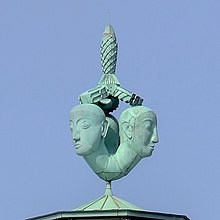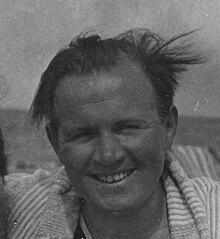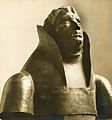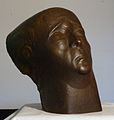Hans Wissel
Hans Wissel (born August 4, 1897 in Magdeburg , † May 18, 1948 in Grainau near Garmisch-Partenkirchen; full name: Adam Johannes Wissel) was a German sculptor , goldsmith and medalist. He renewed the driving technique in Germany, with which he made reliefs and created life-size round sculptures. His technique was groundbreaking: forcing pre-formed individual parts of a plastic made of brass or copper sheet to be joined together by brazing and for further driving to bring them into their final shape. His style ranges from expressionism to realism. Hans Wissel became known for his life-size figures and busts as well as for his filigree metal sculptures, these mostly made of copper.
life and work
1. Training and early work (1911–1924)
Hans Wissel came from a well-known Magdeburg goldsmith family and was trained as a goldsmith, engraver and chaser himself by his father, Oskar Wissel, who was the guild master of the goldsmiths in Magdeburg . After completing his apprenticeship, he worked in his father's workshop. From 1914 to 1916 he took evening classes at the Magdeburg School of Applied Arts and Crafts , a. a. attended Rudolf Bosselt . From 1916 to 1918 he was a soldier in the First World War .
In 1919 he and his brother took over the workshop of his late father as a business partner. This now traded under the name of "Werkstätten für Metallkunst, Gebrüder Wissel". A mark containing the letters PHWM was struck in many works. The manual and artistic work was carried out exclusively by Hans Wissel. He was an outstanding member of the art group Magdeburg, which was an association of young, progressive and mainly expressionist-oriented artists. Initially, Hans Wissel created handicrafts. The shapes were made from silver, brass or copper sheet, the decorations were made by engraving or chasing or were driven out as reliefs. The Grassi Museum in Leipzig bought 4 of his works. He was represented seven times at the renowned Grassi trade fair. From 1921 he broke new ground in driving technology and began to create round sculptures from copper or sheet brass by joining the preformed individual parts by brazing and then giving the plastic its final shape by further driving. In 1923/24 he went to Rome and Carrara (in Tuscany ) for almost a year, where he learned the techniques of bronze casting and (marble) stone processing.
2nd professorship at the Cologne factory schools (1925–1931)

In 1925, Hans Wissel was appointed professor for “monumental sculpture and figurative metal driving ” at the newly founded Cologne factory schools by Cologne mayor Konrad Adenauer . Shortly afterwards he was accepted into the German Association of Artists , in whose annual exhibitions he participated until the forced dissolution in 1936 by the National Socialist Reich Chamber of Art . The director of the Cologne Werkschulen, Prof. Richard Riemerschmid , "valued Wissel's work very much and expressed his positive opinion several times, for example in the personnel report of September 23, 1927: Artistic and craftsmanship excellent. Has special experience in the treatment of metal for plastic work like no other. " At the "German Art" exhibition in Düsseldorf in 1928, he received the gold medal for his work.
Until 1931 he worked with the architects Dominikus Böhm and Otto Bartning , who were the leading modern church builders of the time. The following expressionist propellant sculptures survived the Second World War in churches :
Crucifix (6 m high, 1926), Christkönigkirche , Bischofsheim near Mainz; two life-size figures (tired warrior, woman praying, 1926), Nikolaikirche , Görlitz; life-size crucifix (1922), St. Johann Baptist , Neu-Ulm (1928); the high altar there (1928) with life-size figures (Christ and the Evangelists) and figural reliefs was lost after the Second World War; Baptismal font (1929), Church of the Resurrection , Essen; Life-size crucifix (1931), Heilandskirche , Dornbirn near Bregenz.
The larger-than-life, expressionist crucifix (1928) by Hans Wissel in the avant-garde "Church of Steel and Glass" (Stahlkirche, Otto Bartning, 1928) in Essen was removed in 1935 at the urging of the local council. The pulpit with figural reliefs fell victim to the bombs together with the church, as did the portal (1926) on the main building of the German Red Cross in Berlin. The 6 m high allegorical sculpture (1928) on the Messeturm in Cologne has been preserved. Due to financial problems of the city of Cologne (the sponsor of the company schools) he was - like many of his colleagues later - dismissed in 1931 or his 5-year contract was not extended.
In a small studio in Havelberg in 1932, a Luther statue and a life-size crucifix made of chased copper were created among other things. These, as well as works by Ernst Barlach, Emil Nolde, Ludwig Gies, Rudolf Koch, and Jan Thorn-Prikker were selected in April 1933 for the German contribution in the "Hall of Religions" at the 1933 World Exhibition in Chicago . As planned for a long time, a commemorative coin in 5 RM and 2 RM according to a design by Hans Wissel was issued in 1933 for Luther's 450th birthday . The latter was in circulation with a circulation of one million.
3rd professorship at the Art Academy in Königsberg (1933–1945)
In 1933, Hans Wissel was appointed professor and head of the master's atelier for sculpture at the "State Master's Ateliers of Fine Arts" (the former Königsberg Art Academy ) in East Prussia. There he made a. a. Sculptures in stone for public institutions, as well as historical busts in marble and bronze, among others by Freiherr v. Stein (1935, Gymnasium Schneidemühl ), Martin Luther (1936, Luther Church in Munich), Johann Sebastian Bach (1940, Music Institute of the University of Königsberg), for whom Wissel took measurements on Bach's skull in Leipzig, Nikolaus Kopernikus (1939 University of Königsberg and 1943, Frauenburg), Immanuel Kant (1939, University of Königsberg). An 18 m high SA memorial in front of Magdeburg Cathedral , designed by Wissel in 1934 and pompously inaugurated two years later , was demolished in 1945. With this monumental sandstone sculpture , executed in the National Socialist style , the pacifist Magdeburg Memorial ( Ernst Barlach , 1928/29) was to be contrasted with a visible sign of the future "triumph of Nazi culture" after its removal from the cathedral. A girl's head (1926, lost) was confiscated as degenerate in the Kunsthalle Mannheim in 1937, as was a girl's torso (1926) in the National Gallery in Berlin , which is now again in the New National Gallery . From 1939 to 1945 he took part in the Second World War as a soldier and medic, where he was released for important assignments for longer periods of time. Most of his works from this period have been lost. However, the 6 m large embossed relief, Madonna with angel and cloud wreath (1941), on the front of the baroque pilgrimage church Krossen ( Krosno ) near Wormditt (Orneta) in East Prussia (today Poland) has been preserved. It replaced a baroque wooden relief that was half crumbled and is adapted to this in form and style. About 90% of Hans Wissel's sculptures were destroyed or lost at the end of the war.
4th late work (1947–1948)
Released from British captivity in autumn 1945, Wissel was able to gather his entire family in Grainau near Garmisch-Partenkirchen and provide for their maintenance by making jewelry. In a small workshop from 1947 he made approx. 25 reliefs and heads from chased copper, which often had a religious theme, including a. the relief "Women under the Cross", as well as the heads "Job" and "Christ with a crown of thorns". A larger part of the work from the post-war period is now in family ownership. He was able to finish the head and body for a larger than life crucifix that otherwise remained unfinished. Hans Wissel died on May 18, 1948. About 30% of his entire work had a religious theme. In November 1949 a commemorative exhibition took place in the gallery "Der Spiegel" in Cologne, in which sculptures and drawings from the post-war period were shown. The opening address was given by August Hoff , who had been dismissed from all his offices by the National Socialists in 1933 and was now professor and director of the reopened Cologne factory schools.
gallery
Miscellaneous
His son Klaus Wissel took part in the second Xarifa expedition of the marine researcher Hans Hass and was killed on November 7, 1957 while diving off Suakin .
The metal sculptor Joseph Jaekel was one of Hans Wissel's master students.
literature
- W. Lotz: sheet metal sculpture. On the work of Hans Wissel . In: Die Form, Vol. 3, 1928, pp. 18-23. ( Digitized version ).
- Wissel, Hans . In: Hans Vollmer (Hrsg.): General lexicon of fine artists from antiquity to the present . Founded by Ulrich Thieme and Felix Becker . tape 36 : Wilhelmy-Zyzywi . EA Seemann, Leipzig 1947, p. 110 .
- Wissel, Hans . In: Hans Vollmer (Hrsg.): General Lexicon of Fine Artists of the XX. Century. tape 5 : V-Z. Supplements: A-G . EA Seemann, Leipzig 1961, p. 152 .
Web links
Individual evidence
- ↑ artist. Hans Wissel. German Society for Medal Art, accessed on November 29, 2014 . .
- ^ Wilhelm Lotz: sheet metal sculpture: to the work of Hans Wissel . In: The Form. Zeitschrift für Gestaltende Arbeit 3, Issue 1, 1928, pp. 18-23 .
- ↑ s. Wissel, Hans, Cologne , in: Exhibition catalog of the Deutscher Künstlerbund Cologne 1929. May – September 1929 in the State House , M. DuMont Schauberg, Cologne 1929, p. 33 No. 316 Standing woman , No. 317 Woman , both hammer work in copper. Fig .: p. 109
- ^ History of the Grassimesse Grassimesse website, accessed on June 11, 2017
- ↑ s. DKB membership directory 1936 , in: 1936 forbidden pictures , exhibition catalog for the 34th annual exhibition of the DKB in Bonn, Deutscher Künstlerbund, Berlin 1986. (p. 98/99)
- ^ Rüdiger Joppien: The Kölner Werkschulen 1920–1933 with special consideration of the Richard Riemerschmid era (1926–1931) . In: Wallraf-Richartz-Jahrbuch 43, 1982.
- ↑ Curt Horn: The Passion in the New Art . In: Scherl's Magazin 6, Heft 4, 1930, pp. 338-342 . Classic Modern Illustrated Magazines, accessed June 11, 2017
- ^ New German Church Art at the World Exhibition in Chicago in 1933, Die Form: Zeitschrift für gestaltende Arbeit 8, Issue 6,190-191,1933 Website of the University of Heidelberg, accessed on June 11, 2017; First exhibition of the KD for the "Third Reich" at the world exhibition in Chicago. In: Between Art, Culture and Collaboration, The German Church-Oriented "Art Service" 1928 to 1945 in Context, Dieter Kuske, Dissertation University of Bremen 2012, pp. 243-245. Website of the University of Bremen, accessed on June 11, 2017; Modern Ecclesiastical Art, International Exposition Chicago 1933, (catalog of the German contribution), Kunstdienst Dresden-Berlin, Otto Elsner Berlin, 1933 website of the University of Chicago, accessed on June 11, 2017
- ↑ From the taler to the euro: the Berliners, their money and their coins, Helmut Casper, S164. Berliner Story Verlag 2006 Google Books website, accessed June 11, 2017
- ↑ Detailed description of the Magdeburg SA memorial (accessed on April 10, 2017); Forum of the Section Military and Garrison History Magdeburg: Photo Collection SA Memorial (accessed on April 10, 2017)
- ↑ A dealer of "degenerate" art - Bernhard A. Böhmer and his estate . Edited by Meike Hoffmann. Akademie-Verlag, Berlin 2010, p. 224 . Google Books website, accessed June 11, 2017
- ↑ The sculptor Hans Wissel . In: Rheinische Zeitung , November 24, 1949.
| personal data | |
|---|---|
| SURNAME | Wissel, Hans |
| ALTERNATIVE NAMES | Wissel, Adam Johannes (full name) |
| BRIEF DESCRIPTION | German sculptor |
| DATE OF BIRTH | 4th August 1897 |
| PLACE OF BIRTH | Magdeburg |
| DATE OF DEATH | May 18, 1948 |
| Place of death | Grainau |

















